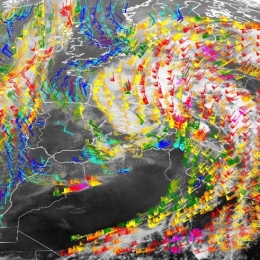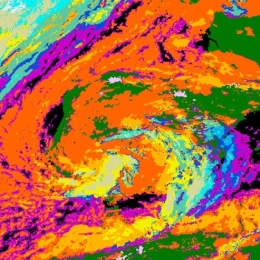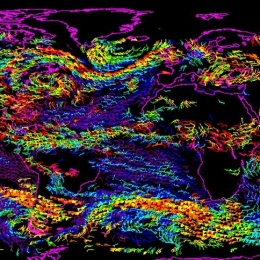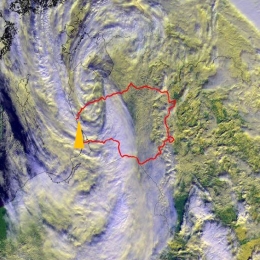Satellite skills and knowledge for operational meteorologist
Listed here are other resources related to Satellite skills and knowledge for operational meteorologist tag:
Note: click on an image to open the Resource
Polly Schmederer presents an evaluation of the EXIM product.
With the latest version of EXIM, new NWCSAF products were added to the list of sub-products and a new extrapolation feature, the so-called CTTH filter, was introduced. The CTTH filter allows extrapolating pixels using atmospheric motion vectors (AMVs) stemming from the same userdefined layer. This talk presents the value gained by extrapolating the new sub-products with EXIM and the impact CTTH-filter has on the extrapolation of the various sub-products.
Alexander Jann presents the NWC SAF product EXIM, its functionalities and the algorithm.
Extrapolated Imagery (EXIM) is one of EUMETSAT's NWCSAF/GEO products. EXIM kinematically extrapolates satellite imagery and selected NWCSAF products by up to a lead time of 1 hour.
The software developer gives an overview over EXIM's functionalities, the algorithm, challenges faced, and recent developments introduced in the latest version, which is currently under review for being released.
Javier Garcia Pereida presents the NWC SAF product High Resolution Winds and shows application examples.
The NWCSAF/HRW-High Resolution Winds product provides a detailed calculation of Atmospheric Motion Vectors and Trajectories locally and in real time by its users. In this moment, it is able to do this in all regions of the Earth with 5 MSG/Himawari/GOES-R geostationary satellites and 12 NOAA/SNPP/Metop/EOS polar satellites (inside NWC/GEO v2021 and NWC/PPS v2021 software packages).
It is useful in Nowcasting applications, for watch and warning of dangerous wind situations, and monitoring of the general atmospheric flow, small scale circulation and wind singularities. It can also be assimilated in NWP Models and Climate applications, with special interest in its global applicability. In this session, examples will be provided considering all these possibilities.
Izolda Marcinoniene gives a talk on the synoptic background for strong winds in Lithuania.
In Lithuania, very strong winds (≥28m/s) are usually caused by Atlantic cyclones. Fifty-five cases in 173 sites have been registered during the period 1961–2021. Even a few cases with very powerful winds (>40 m/s) were observed. According to statistics, most events occur during the cold season and bring significant damage. Thus, a short summary will be presented. Additionally, the typical cyclone track and synoptic situation will be shown in this presentation.
Cecilia Marcos and Natasa Strelec Mahovic give an overview on the NWC-SAF precipitation products and their applications.
To provide the forecasters with tools for severe weather events monitoring with a suitable spatial and temporal resolution is very important. The NWCSAF project develops several products to make easier forecasters their nowcasting tasks.
The NWCSAF/MSG software package contains two products devoted to precipitation. Precipitating Clouds (PC) product assigns a probability of precipitation occurrence on each SEVIRI pixel. Convective Rainfall Rate (CRR) product estimates rain rates on convective, and stratiform associated to convection, events. The algorithms, on which those products are based, have currently two different approaches.
PC product takes advantage of surface temperatures and of those SEVIRI spectral features which have the highest correlation with precipitation, to construct a Precipitation Index (PI). According to this PI, which has been calibrated against rain gauges, a likelihood of precipitation occurrence is assigned to each SEVIRI pixel. CRR algorithm assigns rain rates to each pixel according to some SEVIRI channel information and some calibration functions, which have been calibrated using radar data. The influences of environmental and orographic effects on the precipitation distribution are taken into account through some corrections that use NWP data. Besides, two new products are included in the NWCSAF/MSG v2013 software package. These products also estimate the probability of precipitation and convective rainfall rates using a common approach, which takes advantage of cloud microphysical properties.
In a second talk, Natasa Strelec-Mahovic will present applications of the NWCSAF Precipitation Products.
Hervé Le Gléau and Thomas Krennert give an overview on the NWC-SAF cloud products and their applications.
In this 30 minutes presentation, Hervé Le Gléau (MFL) gives an overview of the cloud products that can be retrieved from the MSG/NWCSAF software. These products are the cloud mask (including dust and volcanic ash flag), the cloud type (including the cloud thermodynamical phase), and the cloud top temperature and height. The algorithms will be outlined and some validation results presented. Finally short information will be given on the new cloud microphysics product planned in the NWC/GEO software version 2015.
In a second talk, Thomas Krennert from ZAMG will present case studies using the NWCSAF Cloud Products.
Pilar Fernandez and Ana Sanchez Pique give an overview on the NWC-SAF operational services and products.
In the first presentation, Pilar Fernández gives an introduction to the NWCSAF. The general objective of the NWC SAF is to provide operational services to ensure optimum use of meteorological satellite data in Nowcasting and Very Short Range Forecasting. To achieve this goal, the NWC-SAF is responsible for the development and maintenance of both satellite derived products and of appropriate SW Packages, as well as user support and related tasks. This lecture intends to provide an overview of the NWC SAF project including objectives, consortium composition, phases, organization, services and products.
In the second part, Ana Sánchez Piqué gives a detailed overview of the NWCSAF User Services provided through the Helpdesk tool. The attendants will be shown the different services available for users and also the information available for non-users. Some statistics about the Helpdesk use made by the users (Mail Box, SPR, etc..) will also be shown.
Jean-Marc Moisselin and Frederic Autones give an overview on the NWC-SAF RDT product and its application.
RDT-CW (Rapid Development Thunderstorm Convection Warning) product is an object-oriented diagnostic for convective clouds or cells. RDT-CW is mainly based on satellite data. RDT-CW software tracks clouds, identifies those that are convective (discrimination), and provides some descriptive attributes for their dynamics. Year after year many attributes have been added to the convection object. These improvements offer end-users the possibility to focus on specific parameters according to their center of interest: dynamic of the system (cooling rate, motion vector) lightning activity, rainfall, main cloud phase of the cell, etc. These attributes may come from various sources such as NWP data, other PGEs (Product Generation Element), lightning network. In the v2013 release, an overshooting top detection inside RDT cell is proposed to users. This new attribute allows to focus on potentially hazardous areas.
In the future releases the description of convective cells will be enriched, giving a high priority to the use of other SAFNWC products. A nowcast of RDT up to one hour will be implemented.
Several SAFNWC processing chains are implemented at Meteo-France over various geographical areas: those covered by MSG of course, but also those covered by other geostationary satellites, like overseas territory where Meteo-France centers are still implemented. Forecasters in these centers are the main users to benefit from RDT as an additional product. Productions over Europe and Africa benefit to Aeronautical forecasters from Meteo-France’s National Forecast center, to French Army, and also to ACMAD, Niamey.
A target visualization tool with nowcasting capabilities will be presented, which allows taking advantage from RDT end-product. Presentation of RDT for various situations and over various areas will also be undertaken, and the latest development implemented in v2013 release will be highlighted.
Javier Garcia-Pereda and Mate Mile give an overview on the NWC-SAF high resolution wind product and its application.
The “NWC SAF/HRW High Resolution Winds” provides a detailed calculation of Atmospheric Motion Vectors locally and in near real time. It calculates the AMVs considering cloud and humidity patterns in up to seven different MSG/SEVIRI channels (HRVIS, VIS06, VIS08, WV062, WV073, IR108, IR120), together with NWP data and the “NWC SAF Cloud products (Cloud type, Cloud top temperature and height)”.
It considers up to two tracer scales (Basic and detailed), two tracer determination methods (Gradient and tracer characteristics), two tracking methods (Euclidean distance or cross correlation), and two Height level assignment methods (Brightness temperature interpolation method and Cross correlation contribution method). As other AMV products worldwide it also includes a quality control flagging based on the Quality Indicator Method developed at EUMETSAT.
NWC SAF/HRW product can be useful in Nowcasting applications in synergy with other data available to the forecaster: monitoring of low level convergence, divergence at the top of developed systems, or other cases of small scale circulation or wind singularities. It can also be used as an input in analysis and forecasting applications like NWP models. The development and main characteristics of the product are explained with examples, useful for the potential users to know what the product can offer. The validation results related to the latest version on the product (HRW v4.0) are also explained.
The role of the Atmospheric Motion Vectors (AMV) in the modern data assimilation systems is evident nowadays. The AMVs – along with satellite observations – have an important key for our operational ALADIN data assimilation system as well. In the framework of the EUMETSAT SAF High Resolution Winds (HRW) products had been developed by AEMET for Nowcasting and Very Short Range Forecasting purposes. The HRW products provide quasi real time data of AMVs from MSG HRVIS and IR10.8 channels every hour in a day. A collaboration between AEMET and OMSZ have been focused to compare the benefit of the operationally used AMVs (received through the EumetCAST) with the newly processed HRW winds. Recent work was an extensive evaluation and monitoring of the assimilation and forecast system. The impact of the AMV winds was examined using different diagnostic techniques, verifications tools and case studies. The first results are promising regarding the use of the HRW AMV. The statistical scores on the full domain showed neutral or slightly positive impact in most of the parameters and the experiment based on HRW AMV data provided better estimate of extreme precipitation events.
Miguel A. Martinez and Maria Putsay give an overview on the NWC-SAF clear air products and their applications.
Since 2010, the PGE13 SEVIRI Physical Retrieval (SPhR) is available as an operational product of the NWCSAF/MSG software package. The algorithm is based on the physical retrieval algorithm for GOES developed by Dr. Jun Li (CIMSS at Wisconsin University) but using RTTOV as the radiative transfer model and the coefficients adapted for SEVIRI. The PGE13 has been optimized for the purpose of operational implementation; near real time images could be seen on the NWC SAF reference system (http://www.nwcsaf.org).
The improvements on version 2013 of PGE13 are presented first. The main improvement on the 2013 version is that it allows the use as the background NWP input of ECMWF GRIB files on hybrid levels; the 2012 version only allows the use as NWP input of GRIB files on fixed pressure levels.
This step is a small milestone in the exploitation of this kind of MSG L2 products. Now, the spatial and temporal resolution could be used together with vertical resolution provided by the hybrid levels GRIB files to get information of 3D structures. The reason it that the use of hybrid GRIB files as input to the algorithm avoids the stepwise aspect on the vertical cross sections created by the linear interpolation between too separated levels in the fixed pressure levels PGE13 version. Other point is that the local execution of PGE13 allows the generation of optional files with fields like 3D equivalent potential temperature arrays. Thus, forecasters can fully exploit the 3D structure allowing the detection of instability vertical gradients on medium levels.
All these changes allow forecasters the use of the PGE13 for a better monitoring of key ingredients in regions where likely triggering of convective storm could develop and also advise of the regions where the NWP disagree with the PGE13 physical retrieved profiles. The use of PGE13 in several case studies will be presented.
The NWCSAF Clear Air product consists of total and layer water vapour contents and instability indices. This product is retrieved from SEVIRI data for cloud-free pixels. As it can be calculated in 15-minute time step, even in 5-minute time step it is usable to monitor convection ability. Case studies will be presentation and analyzed: cases, when the NWP forecasted and the satellite retrieved convective environmental parameters are close to each other and when not. We will show selected cases when the NWCSAF Clear Air product has added value compared to the NWP forecast. The effect of the undetected clouds is also analysed.
As optional output the whole retrieved temperature and humidity profiles can be study. We show a case when the retrieved profiles were also analyzed. Statistical results will be presented on using the satellite retrieved Clear Air environmental parameters to separate stable from unstable environments and the environment where forming severe storm is not likely from the environment where it is possible.
David M. Schultz gives a presentation on the different conceptual models approaches concerning occlusion processes in frontal systems.
This talk presents new conceptual models in cyclone structures and evolutions. How does the large-scale flow in which the cyclone is embedded determine the type of frontal evolution that occurs? How does the air flow through cyclones, and what can this tell us about the possibility for damaging winds at the surface? This talk concludes with general principles for how forecasters can improve their skill through the use of conceptual models in operational forecasting.
Fernando Prates gives a presentation on forecasting the tracks of tropical cyclones (TC). He gives presents the TC products delivered by ECMWF.
In this module the importance of forecasting tropical cyclones (TC) is briefly discussed. An overview is given of the recent developments in the forecast systems at ECMWF with impact on the forecast of TCs, including the recent change in the model’s resolution and the implementation of the Ensemble Data Assimilation. At the present time, any TC formed in the forecast system can be identified using a tracker developed at ECMWF. How does it work and what kind of products that can be derived from it is discussed. Some examples are also presented to highlight the model's ability to forecast the genesis of TCs. Finally the statistics of the forecast performance for TCs is discussed.












